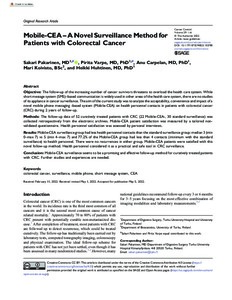Mobile-CEA - A Novel Surveillance Method for Patients with Colorectal Cancer
Pakarinen Sakari; Varpe Pirita; Carpelan Anu; Koivisto Mari; Huhtinen Heikki
https://urn.fi/URN:NBN:fi-fe2022091258590
Tiivistelmä
Objective
The follow-up of the increasing number of cancer survivors threatens to overload the health care system. While short message system (SMS)-based communication is widely used in other areas of the health care system, there are no studies of its appliance in cancer surveillance. The aim of the current study was to analyze the acceptability, convenience and impact of a novel mobile phone messaging -based system (Mobile-CEA) on health personnel contacts in patients with colorectal cancer (CRC) during 2 years of follow-up.
Methods
The follow-up data of 52 curatively treated patients with CRC (22 Mobile-CEA-, 30 standard surveillance) was collected retrospectively from the electronic archives. Mobile-CEA patient satisfaction was measured by a tailored non-validated questionnaire. Health personnel satisfaction was assessed by personal interviews.
Results
Mobile-CEA surveillance group had less health personnel contacts than the standard surveillance group: median 3 (min 0-max 7) vs 5 (min 4-max 7) and 77.2% of the Mobile-CEA group had less than 4 contacts (minimum with the standard surveillance) to health personnel. There were no recurrences in either group. Mobile-CEA patients were satisfied with this novel follow-up method. Health personnel considered it as a practical and safe tool in CRC surveillance.
Conclusion
Mobile-CEA surveillance seems to be a promising and effective follow-up method for curatively treated patients with CRC. Further studies and experiences are needed.
Kokoelmat
- Rinnakkaistallenteet [27094]
